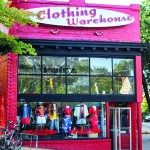
Jamila Waters never really followed the latest trends in fashion.
“I used to be like that,” said Waters, a self-described “super senior” and biology major. While she noticed many of her peers on Georgia State’s campus following the latest trends (think “hipster”), Waters marches to the beat of a different drum.
“I like tye-dye, kind of hippie trends; I like Jeffrey Campbell, [and] the sort of weirdness to his style,” she said of her fashion tastes.
She also prefers quality over quantity.
“Most things that are pricey don’t look thatgood; they look cheap, and they look like the same stuff you could get for cheap.”
Waters is just one of many students who are following a new “trend” in fashion—spending less on name-brands and shopping at thrift stores.
According to the National Retail Federation, 83.5 percent of back-to-college shoppers said the economy still plays a heavy role in their shopping habits.
Many stores that buy and sell second-hand clothing are recognizing that college-age students are becoming more frugal, but they don’t seem to mind. In fact, Celia Rice, the store manager at Rag-O-Rama, encourages and embraces this idea.
“People are wanting to be recessionistas, and the thing is, you can’t tell the difference,” she said. “Everyone looks cute and a lot of the styles that are usually $3,000 are also being manufactured at a much more affordable price.”
Located in the Atlanta neighborhood of Little Five Points, Rag-O-Rama is popular amongst many students at Georgia State. Although the company originally started in Columbus, Ohio, Rice said they’ve become something of a staple in the Little Five district since opening in 2006.
Since they carry vintage style pieces at affordable prices, Rice believes this is why Rag-O-Rama attracts so many college-age students.
“Generally we try to stay on trend…[we buy items] that you don’t see mass-produced over and over again,” Rice said. “In this economy, everyone is bearing down.”
Students like freshman Sumari Muhammad would rather shop somewhere like Rag-O-Rama for this very reason
“…I just like what I like,” Muhammad said of her taste in fashion. “…Some of the outfits I’ve gotten from [thrift stores] are the ones I get complimented on the most.”
Muhammad described her style as eclectic and diverse.
Sophomore Edwin McBride agrees with Muhammad. A frequent second-hand shopper himself, McBride believes shopping at these places gives shoppers a unique experience that can’t be found in name-brand department stores.
“The choice of clothing is fantastic,” McBride said. “It all comes down to having items that are one-of-a-kind that are vintage or retro and the price point that makes them extremely affordable. It shows that it doesn’t have to cost a lot to be cute and fashionable.”
CEO and National Retail Federation President Matthew Shay thinks that on top of all the other increasing fees that come with being in college, students want to spend less on clothing than in previous years.
“College students and their parents, who are likely also spending thousands of dollars on tuition, will be looking for ways to stretch their budgets and find good deals this year,” Shay said in an article on tmncet.com, a marketing media company.
Rice isn’t at all surprised about what the recent study reveals. She said everyone in college eats ramen noodles and shops on a budget, and that includes thrift shopping.
“I think it will continue to be a trend because kids want options,” Rice said.
McBride, who described his style as “old fashioned flare with an edgy modern twist,” said students like himself will continue to shop at stores that sell second-hand items. Still, he does recognize that for some students, a stigma exists about the condition of these items.
“These students usually rely on the same name brands that everyone else is wearing and are ultimately afraid to step out of the box and wear something different,” McBride said. “This stigma comes about because in the majority of thrift [and] vintage stores the clothing might have [an] odd smell to them but that can be quickly fixed with a strong wash.”
Waters doesn’t mind the condition of clothing at second-hand shops.
“I like getting old t-shirts that are like a $1. Shirts that say ‘Joes Crab Shack’on them.”
Despite what critics of thrift stores may think, Rice said these critics will come around eventually.
“I think people aren’t so scared of it anymore. I think there was a stigma that went with it [but]…I think a lot of that stigma is starting to go away.”
For students who prefer expensive, name-brand clothing, Muhammad said there may be something deeper going on.
“Everyone wants to be different enough to stick out but the same enough to be accepted.”
A survey conducted by Campus Entertainment focused on college-age students to see if expensive name-brand items are still a hot commodity.
The survey, which included responses from more than 1,100 college students nationwide, reveals that 63 percent believe that brand names are still “…important or somewhat important.” A few popular name-brand clothing among these students includes Ralph Lauren (42 percent) and The North Face (42 percent).
Despite these results of students on a national level, Rice believes students should be more appreciative of stores like Rag-O-Rama.
“I wish I would’ve had a place like this when I was in high school,” the 28-year-old said with a hint of nostalgia. “[In high school] my mom gave me $75 allowance to shop. Today, [in thrift-stores] that $75 would go a long way.”











